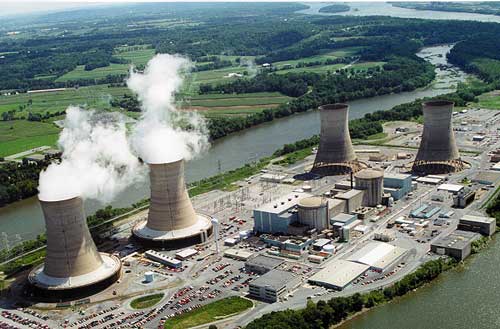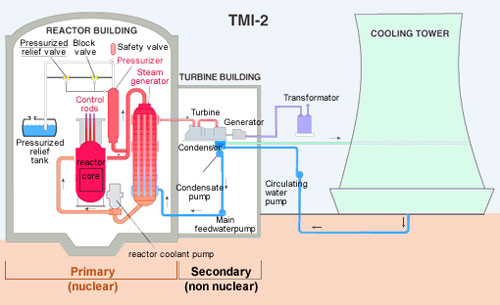1979: A major accident that led to the destruction of a reactor

The Three Mile Island Nuclear Power Plant
The accident at Unit 2 (TMI-2) of the Three Mile Island plant near Middletown, Pennsylvania occurred on March 28 1979 in a heavily populated area. It was the most serious accident in the history of U.S. nuclear reactors, though it has not caused any deaths among the staff or the population. It brought radical changes in the mode of operation of the reactors and helped to strengthen the safety rules of the Nuclear Regulatory Commission. These new steps have the effect of improving the safety of reactors in the world.
© IN2P3
The Three Mile Island plant (TMI) is located on the Susquehanna River in Pennsylvania USA. Unit No. 2 included a pressurized water reactor (PWR) of design similar to those built in France, but with a different disposition of the steam generator and the core vessel.
The reactor operated normally during the first 3 months following its start-up when, on March 28, 1979 at 4:00 occurred an operating incident on the « secondary » circuit. This incident caused the loss of the main water supply.

Schematic of the reactor TMI-2
The Three Mile Island plant unit involved in the accident was unit 2 (TMI-2). The scheme shows the main components of this pressurized water reactor. The accident originated in a failure of the main pumps water supply in the non-nuclear part of the reactor combined with a false signal of a reserve valve (discharge valve of the pressurizer) declared closed while it remained open. The overheating of the reactor caused the melting of the core, but the containment of the reactor building was not affected..
© Source NRC
The accident began with the loss of sealing of the enclosure of the primary circuit of water – the second barrier of protection – a discharge valve of the pressurizer having remained permanently open. As a result of wrong diagnostics and inappropriate actions, the cooling of the reactor core was no longer assured, leading to a partial fusion of the nuclear fuel, that is to say the loss of the first barrier of protection.
The reactor building containment has played its role of ultimate barrier perfectly with the exception of a small radioactive leak (limited in scope and duration) due to non-isolation of transfer water from the sump of the reactor building to that of the nuclear auxiliary building, a conception error.
These low environmental releases were caused by the system pumping water from the sump located below the primary circuit and that remained active. Pumps have, for several hours, transported in the « auxiliary building » water increasingly loaded with radioactive materials. Contaminated hot water was sprayed in this building, releasing xenon and a part of iodine contained in the environment.
The accident was classified at level 5 on the INES scale. When six years later, it has been possible to enter the compound, a camera inserted into the vessel showed that some fuel had melted but did not escape through the vessel. The reactor was lost, but there were no victims.
In the former Soviet Union, the authorities were silent for a time about the severity of the accident at Chernobyl. Nothing like that in an open society such as America. The accident was highly publicized. Thousands of motorists fled along the roads of Pennsylvania, before returning to their homes once the alert was lifted. The accident, the exodus, the dramatization of newspapers and television caused a deep trauma.

TMI : A reactor core fusion
Cross-section of the reactor vessel showing the fuel degraded by partial melting of the reactor core. 45% of the fuel melted, including cladding and structure materials to form a « corium« . The photography taken by a video camera, inserted down the vessel 4 years after the accident, shows the fusion of elements of uranium fuel with damages more important that had been originally assumed. The reactor core was damaged beyond repair, but there was no major radioactive release into the environment.
© IRSN/IAP
Three Mile Island led the U.S. to abandon the construction of new power plants, following a decision taken by President Jimmy Carter. The U.S. nuclear industry, hitherto dominant, lost its leadership in favor of Europe and Japan. Carter doctrine lasted nearly 30 years. But, on January 27, 2009, in his State of the Union address, President Barack Obama has called for « a new generation of nuclear power plants safe and clean. »
The accident had finally positive impacts in terms of « reactor safety. » Many lessons were learned, leading to multiple measures to improve safety. A safety culture has been developed. The absence of accidents recorded since 1979 in the park of Western reactors is a legacy of Three Mile Island.
Other articles on the subject « Nuclear Accidents »
The INES scale
The severity scale of nuclear accidents Nuclear installations and their operation are complex and[...]
Accidents of radioactivity
The importance of a close monitoring of radioactive sources… In many countries, the possess[...]
Accident Causes
Human errors, design flaws and natural cataclysms A nuclear accident dwarfs all other types of ac[...]
Mayak Accident
A military long-hidden nuclear accident of the Soviet era Long before Chernobyl, it was suspected[...]
Windscale Accident
Windscale : an accident of the U.K nuclear weapon program (1957) The fire which occurred the 10th[...]
Tokaimura Accident
1999 : a « criticity » accident in Japan This surprising accident of « criticality » came about i[...]